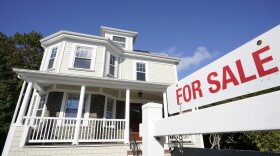For Patricia Iñiguez and her family, the pandemic was the final push to move out of their suburban West Asheville home and into the woods.
“The land that we are going to be building on, we love it, it’s beautiful, it’s pretty much in the forest,” Iñiguez said. “We knew that we wanted to be there, and I think the pandemic made it more clear.”

Iñiguez works part-time from home, her husband’s a teacher, and together, they’re rearing a toddler. They received the wooded lot in Mills River four years ago as a gift from family and had enough in their savings to break ground this year. Or, so they thought.
“We had talked to a builder that thought at first he knew what he wanted and thought it was in the budget, and then later was like, ‘lumber is getting really pricey, so what you had in mind is no longer within your budget,’” Iñiguez said. “That was the first time it kind of hit us, there was a huge increase in pricing.”
The builder came back to her with a price that was tens of thousands more than what they had originally been expecting. It was back to the drawing board.
It turns out, many people wanted to move to the mountains this past year. The housing construction industry is booming in Western North Carolina. Just seven months into 2020, the number of home construction permits had already surpassed all of the permits for the previous year.

“2021 data shows that increases in new home construction are accelerating,” Jerry Hedrick, business technology project manager for the City of Asheville, said. An analysis of construction permits for new single family homes rose 4 percent during the pandemic, from March 18, 2020 to March 7, 2021.
“It’s crazy out here. Demand is extremely high, and the costs of everything that go into a home are rising more quickly than we’ve seen in the last 20 years,” Jody Guokas, president and founder of JAG Construction, said. His company is one of the larger home construction firms in Asheville, with 24 employees.
For smaller companies, like Blue Stone Construction in Hendersonville, it was also the busiest year on record. President Kevin Reed says he hired four employees during the pandemic, nearly doubling his staff. He says he started to notice inquiries for home construction picking up in late spring.
“People just started coming out of the woodwork and either wanting to escape New York City, or come back up from Florida,” Reed said. “A lot of people are having the flexibility of working from home or a home office, so they started exploring stuff.”
Reed’s firm specializes in luxury mountain homes. He says they typically don’t take on projects lower than a million dollars. Regardless, he says, he did lose one client to the skyrocketing lumber costs. It increased the budget of a $2 million home by half a million dollars.
“The mills, the pressure-treating plants were closing up because everybody was getting the virus,” Reed said. “But I think the bigger reason is just supply and demand, literally economics. People moving here, building homes, and building homes more than they were.”
While the increased demand is good news for the construction sector, it poses socio economic challenges for Asheville and the surrounding region.
Before the pandemic, the city was already experiencing a shortage of affordable housing stock -- both rentals and homes for sale.
“I just don’t see how it’s sustainable, when it comes to housing,” Iñiguez said. “When we moved to Asheville seven years ago, both of us working full time, and no kids, with our budget, we could find a house -- not a new house, but a decent house -- around West Asheville or Asheville.”

And, she says, now that’s almost impossible. Because of the appreciating home values in Asheville, they were quickly able to sell their home, which gave them a little more wiggle room in their construction budget. They also found another builder who was willing to work with them.
“I feel for those that are not as lucky, as privileged as we are that we had some land that we didn’t have to pay, and then we also were able to sell when the market was so hot and we made quite a bit of profit,” Iñiguez said.
The median home price in Asheville in 2020 was a little over $420,000, while the median household income was just $56,000. Iñiguez says she worries that working class people are losing out on a path to home ownership -- further widening the wealth gap.
Correction: In the original version of this story, we incorrectly stated the median home price in Asheville in 2020 was a little over $540,000. According to data from Realtor.com, the median home list price in 2020 was $420,975 for Asheville Metro and $449,900 for Buncombe County. The media home list price for January-April 2021 was $480,195. The article has been updated.




